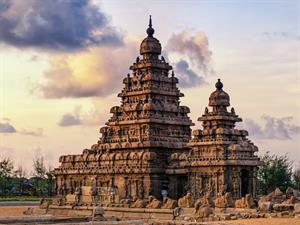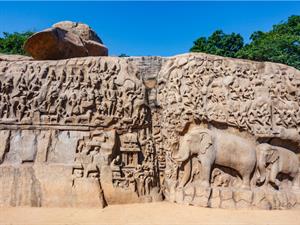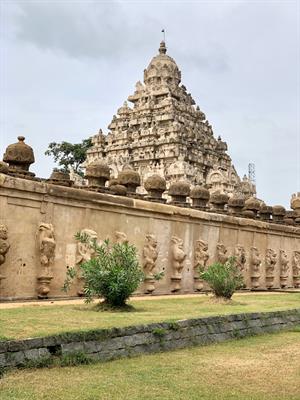PDF chapter test TRY NOW
Introduction:
The temples of Tamil Nadu had their significance in the history of architecture in India. The heritage of Tamil Nadu is very rich when compared to the other South Indian states. The temple building phase began in the \(7^t\)\(^h\) century in Tamil Nadu.
The ancient history of Tamil Nadu and its culture are highly intertwined with the presence of temples. They also developed a unique style of architecture named “Dravidian Architecture”.
The craftsmanship displayed by the sculptors of the ancient period was evident in the temples of Tamil Nadu. The temples of the state witnessed numerous styles under various reigns; they are given below.
The Pallava Architecture:
The Pallava kings were great patrons of art and architecture. Their period witnessed the emergence of long free-standing temples which were earlier absent in South India. The Dravidian style of architecture began under the Pallavas.
The Pallava reign also witnessed a transition in temple architecture from the “Rock-cut temples to the Free-standing temples”.
Rock-Cut Architecture:
The Rock-Cut architecture reached its zenith under the Pallava dynasty, where a huge rock was carved out in different shapes and sizes, which were later used to build temples.
The pillars are carved in the front side of rocks that serve as the “Mandapa”, and the rear side is left to construct the Sanctum of gods.
Mahendravarman: He was the ruler of the Pallava dynasty who was the pioneer in rock-cut architecture. He also introduced a new style named the “Mahendra style” in architecture. Mandagapattu was the first rock-cut temple built by him.
Mahendravarman I was a great patron of art and architecture and wrote a play named “Mattavilasa Prahasana” in Sanskrit. The style of rock-cut temples made way for the large range of temples after the reign of Mahendravarman I.
Mandagapattu: The earliest rock-cut temples were built with a single rock without wood, metal and bricks. “Dwarapalakas” are royal gatekeepers carved in this temple’s entrance, which later became a feature of most south Indian temples.
The Mamallapuram Shore temple:
The Mamallapuram is a coastal area located on the Eastern coast of Tamil Nadu. The area is rich in history as some of the earliest accounts of foreigners had mentioned the flourish of trade with the Romans along the coast of Mamallapuram.

Mamallapuram
The architecture of Mamallapuram (Mahabalipuram) personified the greatness of the Pallava architecture. These temples are built with granite by the Pallava King “Narasimhavarman I”, who was the successor of Mahendravarman I.
Narasimhavarman I: He was also known as “Mamallan" or the “Great wrestler” from whose sobriquet the city of Mamallapuram derived its name.
The Shore temples and monuments of the Mamallapuram were designated as UNESCO world heritage sites in 1984.
The 7 Pagodas:
The term is associated with the Shore temple of Mamallapuram, where the main temple was associated with six other temples submerged under the sea due to natural calamities.

Arjuna’s Penance
The architectural splendour also contains the “Pancha Pandava Rathas” and “Arjuna’s Penance” which are intricately carved in a 100 feet long stone.
Other structural temples of Pallavas:
1. Kanchi Kailasanathar Temple:
This temple is located in Kanchipuram, built by Narasimhavarman II, also known as “Rajasimhan”. The temple was built using blocks of rock.

Kailasanatha temple
It contained well-balanced sculptures with intricate carvings which inspired the kings of other dynasties. The sculptures of “Lion” were synonymous with the Pallava temples.
Kailasanatha temple: This temple inspired the Great Chola king “Rajaraja I” to build the Brihadeeshwara temple in Tanjore, which by itself is an engineering marvel.
2. Vaikuntha Perumal temple:
This temple was built by the Pallava King “Nandivarman II” in the patronage of Lord Vishnu. The temple was earlier known as “Parameshwara Vishnu Graham” and is also considered one of the holiest shrines of Lord Vishnu.
Nandivarman II: Parameshwara was the real name of “Nandivarman, from whose name the temple of Lord Vishnu was named.
